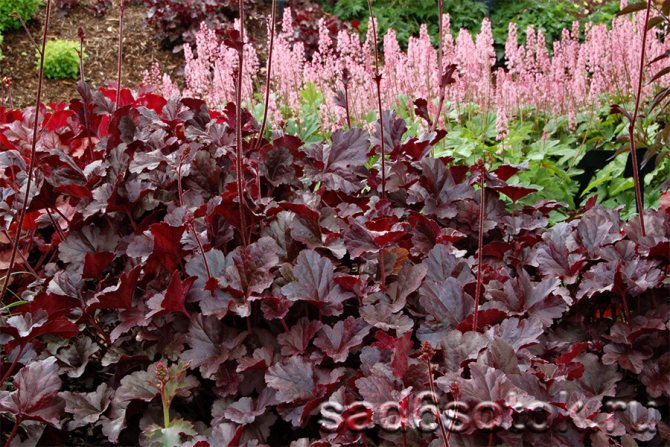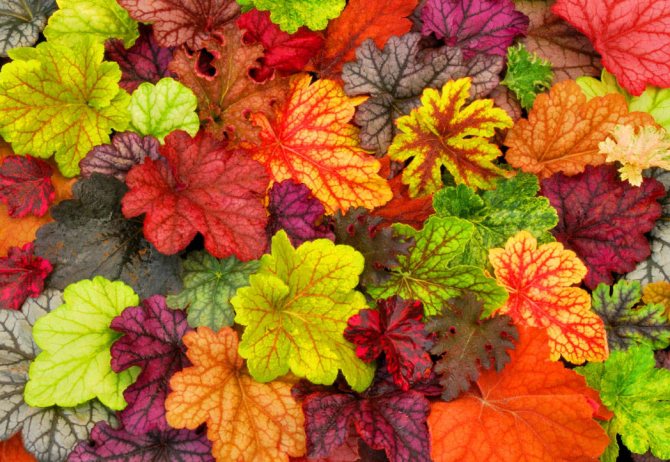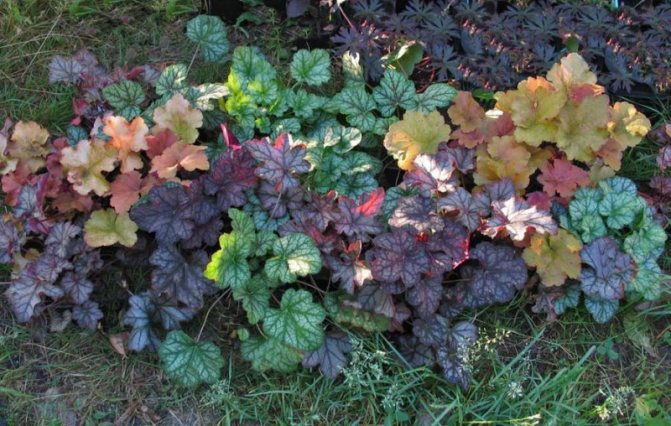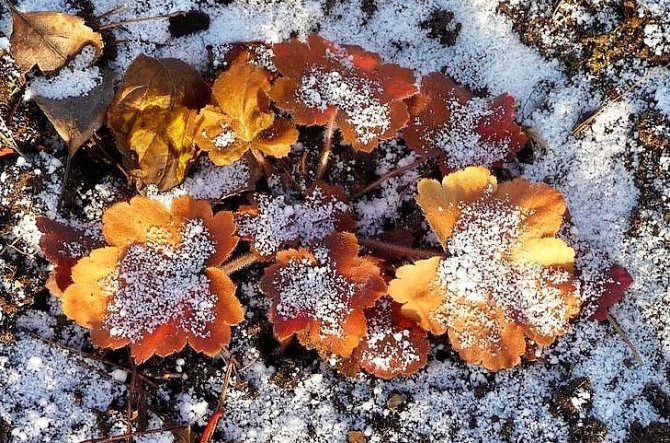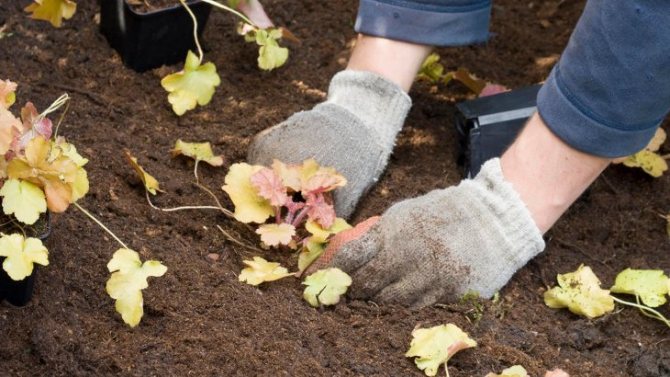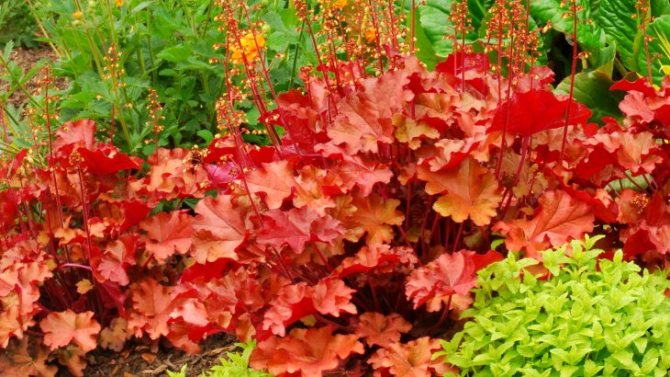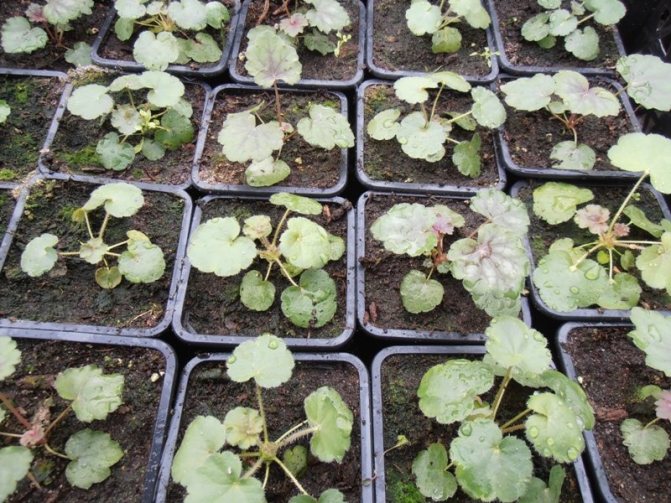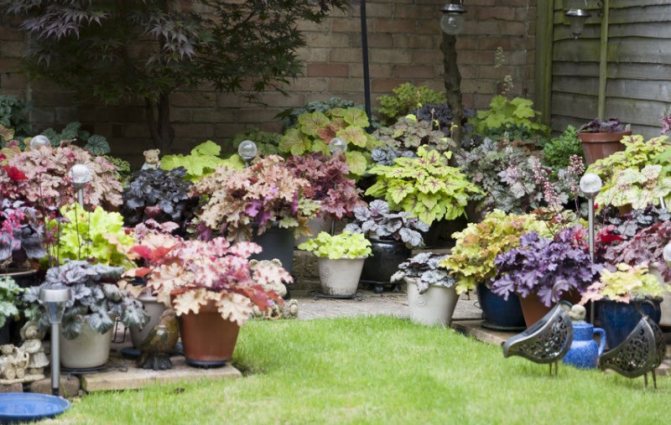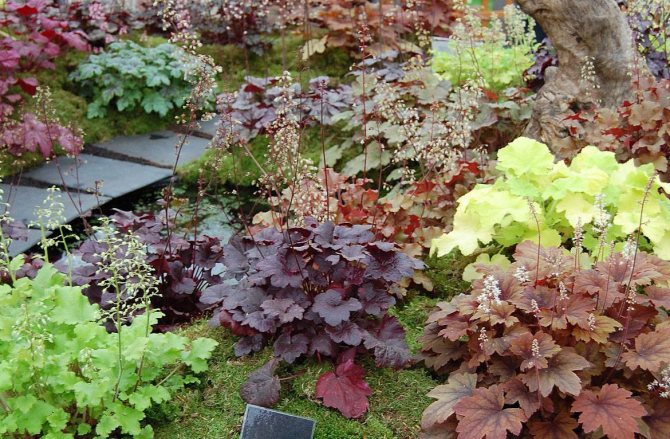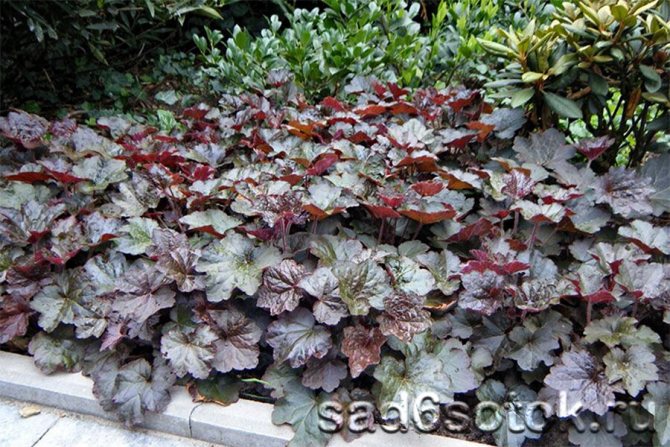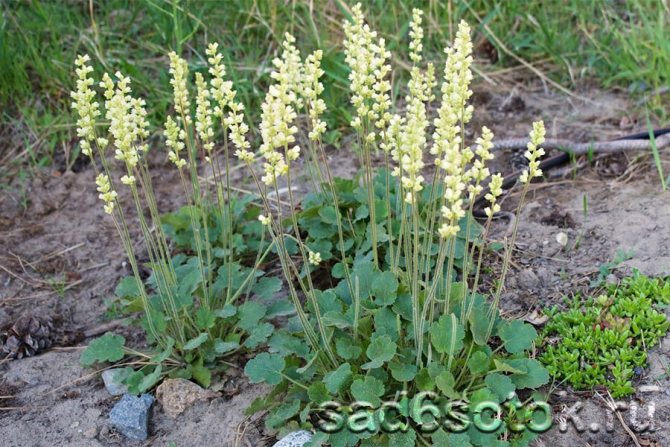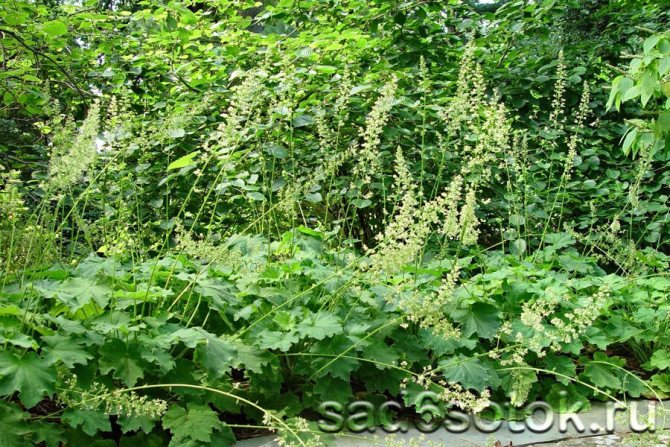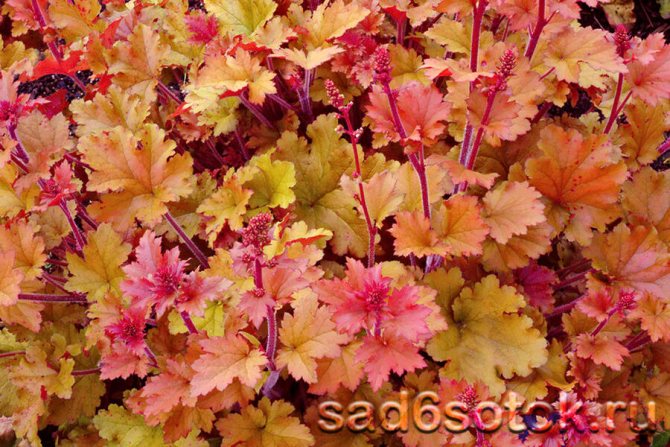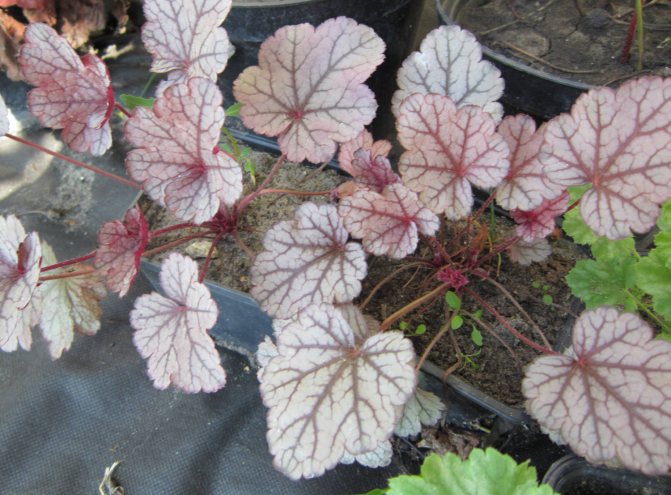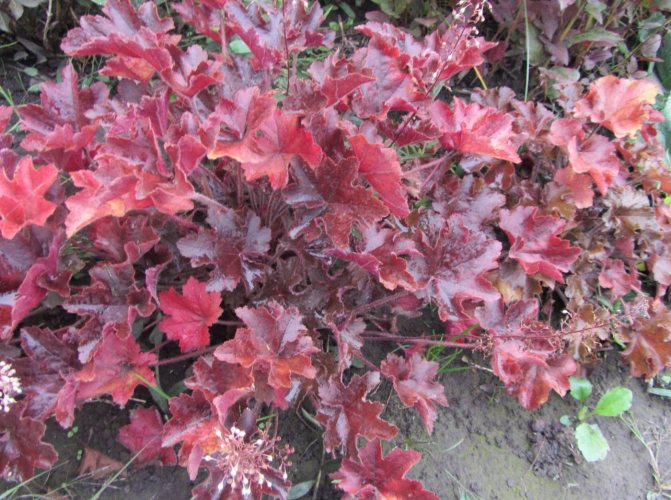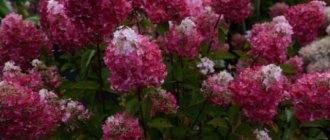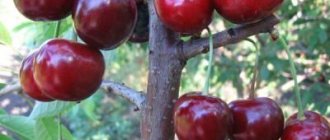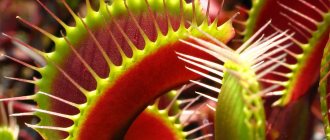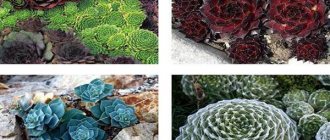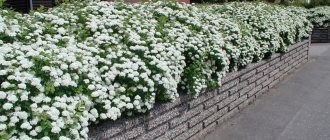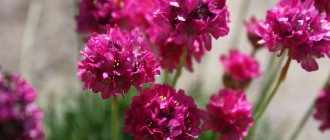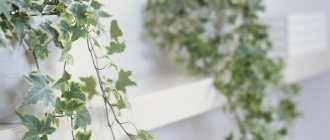Heuchers adorn any flower bed thanks to the graceful decorative leaves of various colors. Openwork patterned foliage and bright flowers on a high stem can be both a frame for a flower garden and its accent. There are more than 70 varieties of geyher, among which there are wild and cultivated ones. A large number of varieties of this perennial plant have been bred for cultivation in the garden.
- Types of Heucher
Blood red
- Cylindrical
- Hairy
- Small-flowered
- American
- Photo gallery: so different geyher
Briefly about the plant
The bush is densely assembled from leathery toothed leaves protruding from long cuttings.
The color of heuchera leaves can be different: black, bright red, maroon, amber, pink, purple, yellow, green and silver. They can also be covered with patterns, veins, specks and specks. The leaves of the plant are smooth, corrugated and curly. The flower blooms in early summer and blooms before the first frost. The plant has small pink, cream, or red bells that gather in panicles. Seeds ripen in a box of heuchera, which can be planted in the ground for the purpose of plant propagation.
Varieties of Heuchera
Gardeners carry out planting and care in the open field of different varieties of Heuchera. The following plant varieties are grown on the territory of our country:
- American Heuchera. Plant height 20 centimeters. The leaves are rounded, slightly serrated. At the bottom they are painted purple, and at the top they are dotted with contrasting veins. The leaves of this variety look most vivid in spring and autumn;
- the hairy heuchera has fleecy leaves, petioles and peduncles. It comes in different colors. Grows up to 20 centimeters up;
- red-leaved heuchera is considered to be the most spectacular of all varieties. Her leaves are dense. The color varies from deep pink to raspberry and red. The leaves have small notches at the edges;
- the gooseberry-leaved heuchera has small leaves with three or five lobes. The bushes are 15 centimeters high. The flowers of the plant are large and white.
In addition to the listed varieties, there are many others that also look pretty on any site.
The use of heuchera in landscape design
The plant does not lose its decorative effect from the earliest spring to late autumn, the first snow (during the period of the first frosts, it becomes even more beautiful), which means that its possibilities of using in landscape design of shady areas of the garden are very high.

Heuchera can be used as in mixborders together with other perennials, in other words, in group landingsas well as quality tapeworm plants, and in the sense that there will be only geyher of different shades.
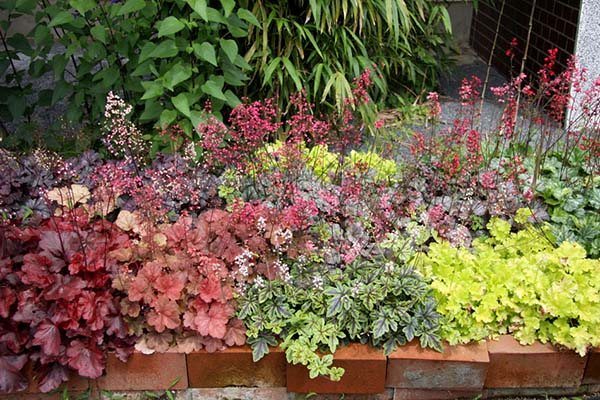

Heuchera look especially beautiful in the form curb planting (along the garden path).
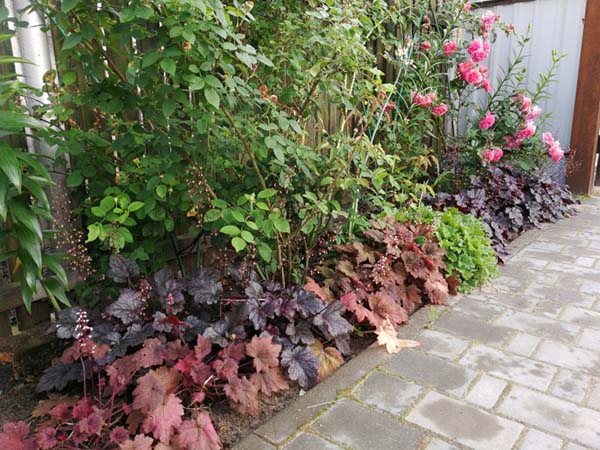

In general, Heuchera, like almost everyone shade-loving plants, will look very impressive on flower beds of stones - in rockeries, and also on alpine slide.
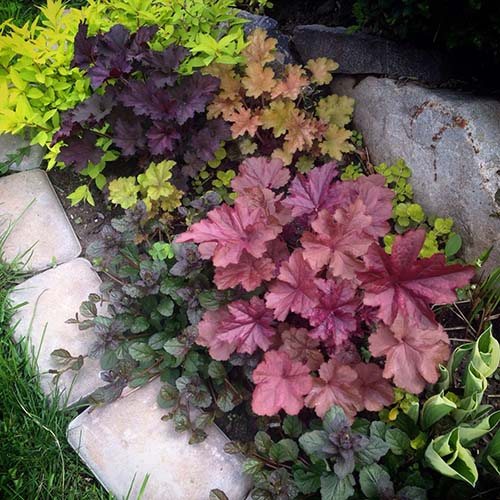

By the way! Heuchera can also be grown as a container culture.
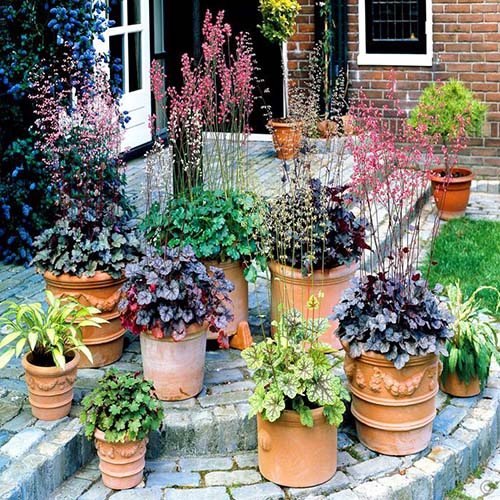

As for the neighborhood, the Heucheras will be great friends with the following plants, including in combinations with (most of them shade-loving):
- hosts;


- fern;
- roses;
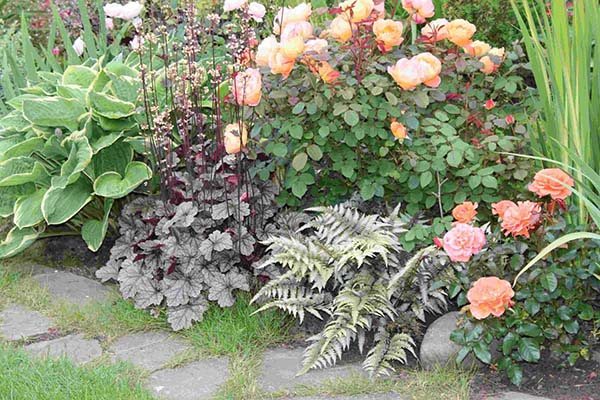

- dicenter;
- astilbe;
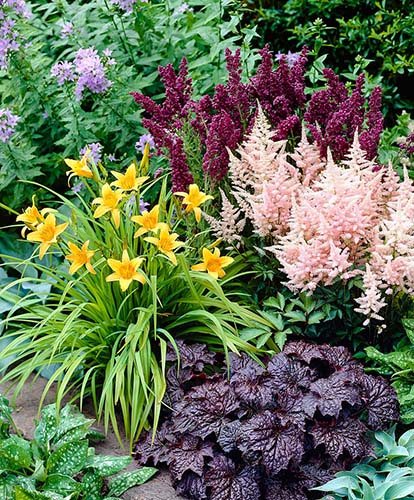

- lilies;
- daylilies.
Important points of growing a plant
Before you start planting Heuchera, it is recommended to read the following information:
- if you decide to propagate an ornamental deciduous plant using seeds, but want to preserve its picturesque appearance, it is recommended to remove the first peduncle;
- in decorative flowering varieties, peduncles are cut off after the buds wither;
- mature bushes shed their leaves after a while, which makes the heuchera less decorative. To prevent this, dig up the plant before it begins to bloom. Transplant it to another hole;
- young seedlings have a delicate, translucent bright color. After a while, they thicken and become darker and more saturated.
Winter preparation and spring care
The plant does not tolerate winters with little snow. Therefore, in the fall, the bushes are mulched with peat, humus, sawdust, needles or oak leaves.
Advice! Initially, the seedling is buried in the ground so that its buds are not close to the surface and do not freeze.
In winter, the bushes are covered with spruce branches from the spring sun, but this can be done in early spring. In the spring, the shelters are removed after the snow has completely melted. Serious structures for shelter in the middle lane of Heuchera are not required, since this is a winter-hardy plant.
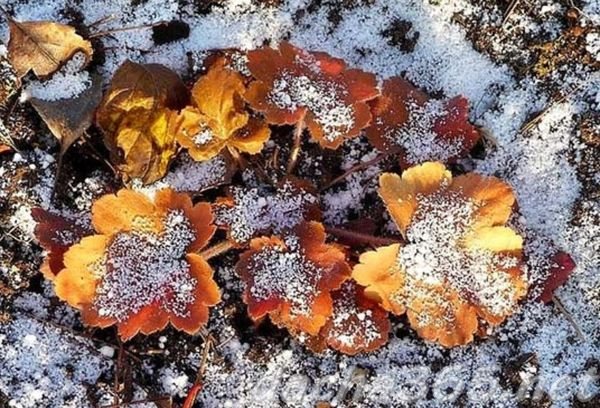

Important! In the fall, the leaves are not cut off, only dry and burnt specimens are cut in the spring.
Watch the video! Preparing geyhera for winter In some varieties, the leaves burn out from the spring sun, since the root system is still frozen and the leaf plates cannot evaporate moisture. They must be cut in the spring.
Features of planting a plant


To plant and grow beautiful plants, it is important to choose the right time and place for planting Heuchera.
Timing a place
Planting material is planted in open ground in March or April. It is recommended to plant a Heuchera plant in the east or west side of the site, as it loves shaded areas.
If there is no shade in your garden, Heuchera can be planted in the sun, but in this case, it is important to water it regularly.
Under the influence of sunlight, the leaves of decorative deciduous varieties become more attractive. Plants with pink or red leaves are recommended to be planted in a well-lit, sunny area.
What should be the soil
The soil should be fertile and have neutral acidity. Heichera loves soil with a pH level of 5-6. To increase alkalinity, crushed chalk and wood ash are introduced into the soil. Fertilizer must be applied before planting.
To prevent water from stagnating in the pits, it is important to constantly drain the soil. Otherwise, the roots of Heuchera will be covered with a fungal bloom and disappear. To create drainage, place a layer of expanded clay or crushed brick into the dug holes before planting plants. The drainage layer will absorb water, which it will share with the plants in dry weather.
Planting methods
Heuchera planting is carried out in two ways: by sowing seeds or planting seedlings. If you bought seeds, plant them in prepared soil. Sprinkle gently with soil and pour over. To plant seedlings in open ground, they must first be grown in a greenhouse. Ready seedlings are planted in loose soil to a depth of 3 centimeters and at a distance of 20 centimeters from each other. Heuchera from seeds or seedlings will germinate in 30 days with proper care.
When to plant Heuchera in open ground: timing
The optimal time for planting Heuchera is Springwhen the soil has warmed up enough, the weather has stabilized, and the threat of return frosts has passed, that is, for the Central strip (Moscow region) - this is approximately the second half of May-early June.
Can be planted and in the fall, but not very late (in late August - early September), so that the plant has time to take root before the first frost (it takes a little more than 1 month for rooting on average).
In principle, it is allowed and summer landing of heuchera (necessarily with an earthen lump and with subsequent shading after planting), but in fact, container plants can be planted all year round.
According to the lunar calendar in 2020
It can help you to choose the optimal date for boarding. Moon calendar.
So favorable days for planting geychera in 2020 according to the lunar calendar are:
- in March - 4-6, 12-14, 26-31;
- in April - 1, 2, 5-7, 9, 13-15, 24, 25;
- in May - 2-6, 15-17, 20, 21, 25-31;
- in June - 2-4, 6-9, 11-14, 23-25;
- in July - 6-11, 13-16, 23-29;
- in August - 5-7, 20, 21, 23-25, 27-30;
- in September - 9-11, 15, 16, 19-21, 26-28;
- in October - 6-8, 21-23;
- in November - 9-13, 22-24, 27, 28.
Unfavorable days according to the lunar calendar for 2020 (the days of the Full Moon and New Moon, as well as the period when the Moon is in Aquarius, since this is a barren and dry sign - italicized) the following dates for the landing of Heuchera are:
- in March - 9, 19-21, 24;
- in April - 8, 15-17, 23;
- in May - 7, 13-14, 22;
- in June - 5, 9-11, 21;
- in July - 5, 7-8, 20;
- in August - 3, 4-5, 19, 31;
- in September - 1, 2, 17, 27-28.
- in October - 2, 16, 24-26, 31
- in November - 15, 20-22, 30.
According to the lunar calendar from the magazine "1000 Tips for the Summer Resident".
Features of plant care
It is very easy to care for a Heuchera. During the first year of the growing season, in the year of planting, the plant does not require additional feeding. After a year, heuchera needs to be fed with universal or complex fertilizers. Top dressing is carried out before and after flowering. It is recommended to reduce the dosage of fertilizers by half what is indicated on the package.
You need to water the bushes regularly: every few days. If the summer is very hot, the flower should be watered in the mornings and evenings every day. The stream of water must be directed directly under the bush so that it does not fall on the leaves.
To avoid weeds and loosening the soil after each watering, mulch the planted heucheras with peat in the spring.
Plant propagation methods
Heuchera propagates from seeds, by dividing bushes or by cuttings. Each method has its own characteristics.
Seed propagation
It is very simple and easy to propagate Heuchera by sowing seeds. You get young bushes with a beautiful appearance. But, if hybrid varieties are propagated in this way, they may lose their varietal characteristics. It is best to buy seeds in special stores or collect them yourself from faded baskets. It is recommended to sow the seeds in the ground no later than six months after they were harvested. Since after six months they lose their germination and not all can germinate.
You need to sow seeds during March. The land for seed propagation of Heuchera must be fertile. First of all, disinfect it, place it in special boxes, moisten and loosen it. You can also sprinkle some sand on top. Sow the seeds in prepared soil and place the crates in a shaded area. It is important to maintain soil moisture at all times. You need to grow seeds at a temperature of 22 degrees. The first shoots will appear 21 days after sowing. When the sprouts grow up, they are transplanted into separate glasses, which are placed in a greenhouse for rooting. When the seedlings take root, they are transplanted into open ground.
Popular types and varieties of Geykhera with photos
It will take a lot of time and effort to review and compare all the varieties of Heuchera available in the world. However, there are those species that are the most common, adapted to temperate climates and therefore are deservedly popular among breeders and flower growers.
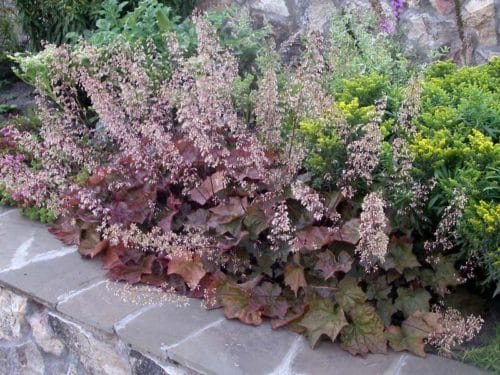

The Heuchera flower looks harmoniously on personal plots among other plants, being a real decoration of the flower bed. Moreover, the shrub retains an attractive appearance for almost 9 months a year
It retains its attractive appearance for almost 9 months a year.
To choose specific varieties of a perennial plant and plant it at home, you need to understand not only their varieties, but also understand the features of caring for Geyhera.
The shrub cannot be called demanding on environmental conditions, some species are even able to survive prolonged heat and drought.
However, the attention and time given to the flower will definitely give good results, no matter what kind it is.
Geichera Caramel
It is this type of flower that is distinguished by rare and meager flowering, because all its strength and energy is spent on growing bright beautiful leaves. As a rule, this type of shrub grows small in size - up to 30 cm in height. The bright yellow leaves of Heuchera can be seen from afar, they retain their freshness and charm from early spring to late autumn. Heichera Caramel blooms with small light pink buds.
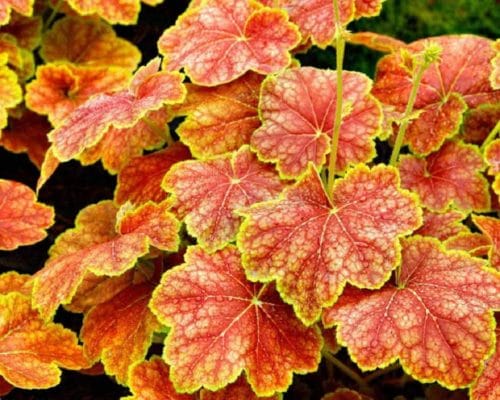

One of the brightest and most colorful plant varieties - Geichera Caramel - comes from the southeastern part of North America, where the hot sunny climate contributes to the active growth and flowering of the shrub
American
Geichera American is famous for its red veins that appear on leaves when exposed to low temperatures. Therefore, this variety grows best near mountain rivers and lakes with high climate humidity. The shape of the leaves of this perennial species resembles a small heart.
In modern domesticated conditions, the red edging and veins may not even appear on the Heuchera foliage, although it can sometimes be replaced during the fall or spring transition period.
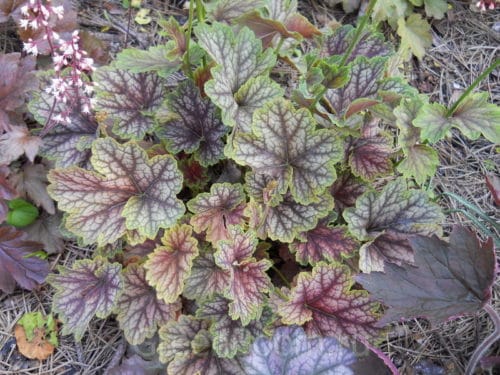

This species is also called mountain geranium because it grows in the highlands of North America. Breeders have learned to grow it in temperate garden conditions
Geichera Red
Another name for this shrub variety is coral bell due to the color and shape of the buds it produces. Unlike many other varieties of Heuchera, this species is distinguished by leaves growing on long thin legs. Due to the beauty and unusual appearance of this variety, it was one of the first to grow and cultivate it. Another difference from the rest of the species is that it loves moisture, needs regular watering and withers away from drought.
Today, the red Heuchera shrub can become an original decoration of any flower bed or garden.
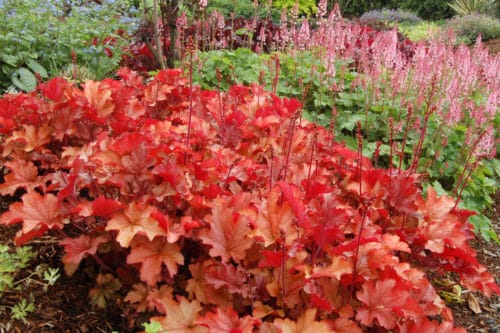

The Red Geykhera variety is distinguished by bright scarlet leaves and inflorescences of the same color, which makes it unlike any other. In addition, it is this type of plant that perceives drought most comfortably.
Hybrid
A shrub with large openwork brown or lilac leaves is one of the most beautiful species of Heuchera. This variety blooms with small loose buds, the colors of which vary from white to dark red. Moreover, the flowering period is one of the longest among all plant species. The inflorescences are located on a long, thin stem, because of which they can be damaged by strong gusts of wind.
On the leaves of Geykhera, veins of a darker color than their color are clearly visible.
This combination of shades and shape creates a whimsical look, for which this variety is loved by many growers.


Geykhera Hybrid was obtained by crossing two varieties - hairy and American. Beautiful wavy foliage is different from other species
Delta Don variety
The peculiarity of the Delta Don variety is that, depending on the location, the leaves of the shrub can have a different color: from light green to dark red with a bright yellow border around them. The shrub feels best in a shaded place, although it will actively grow in an open area with constant access to the sun. It is important to ensure good soil moisture.
The Geykhera Delta Don variety is another option for decorating paths or borders on a personal plot, since the height of the bush does not exceed 30 cm.The flowering period of the plant falls in June-July.
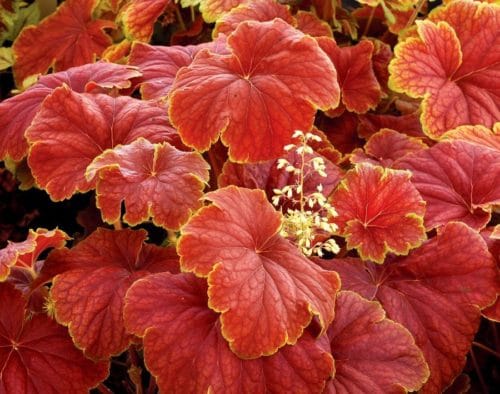

Along with the unusual bright appearance of the Heuchera Delta Don leaves, it also has increased resistance to diseases, pests and climate change.
Geykhera Small-flowered
This plant variety has beautiful leaves that resemble maple leaves.Their dark color is often diluted with a silvery pattern - veins. However, the greatest distinguishing mark is the flowers - small pink inflorescences that cover the top of the shrub during the flowering period. It is for this that the flower got its name.
A perennial shrub loves moisture, calmly tolerates both direct sun and partial shade.
Propagated by dividing the bush, although some growers prefer to collect and germinate seeds.
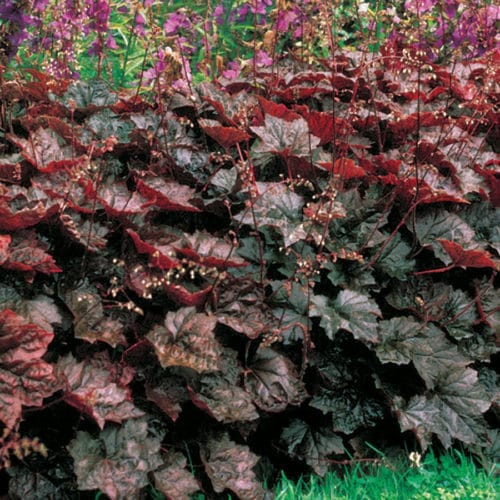

The original home of this variety was the Atlantic coast, as the plant loves moist soil and climate. Although considered to be a fairly stable species of Heuchera
Variety Purple Castle
A feature of this variety of Geykhera is that, depending on weather conditions, the color of its leaves changes hue and can become almost black. All the more picturesque and unusual light pink flowers look against their background. The period of growth and development of this variety is 3-4 years. After that, the shrub will only grow in breadth, increasing the area of its location.
The unusual color of Geikhera goes well with other plants in flower beds. It looks especially bright next to the fern, standing out against the background of its light green leaves. When planting several varieties of Geykhera, many gardeners place the Purple Castle variety in the center of the composition.
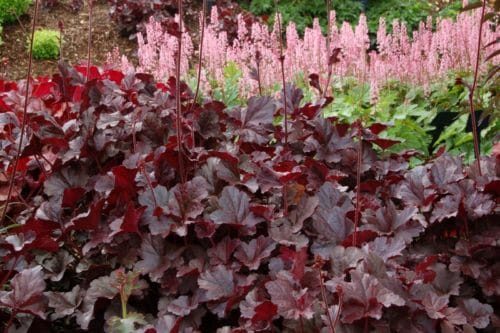

The purple castle is a bit like the Red Geyhera variety, but the color of its leaves is much darker, closer to purple. In addition, veins are visible on ivy leaves.
Geichera Melting Fire
The main feature of this variety is the unusual shape of the leaves - wavy, openwork, with an edge of small teeth. The change in their shade occurs gradually, and during some period of growth they look multi-colored and swirling. Florists use this feature of the variety, planting young and more mature shrubs nearby, resulting in an interesting and unusual combination of shades.
Heuchera of this variety blooms for a very short time - a couple of months in early summer.
Peduncles are attached to long, straight stems, and when blossoming are white or light pink. Against the background of dark leaves, they look unusual and bright. Melting Fire loves moist soil, but tolerates short periods of drought.
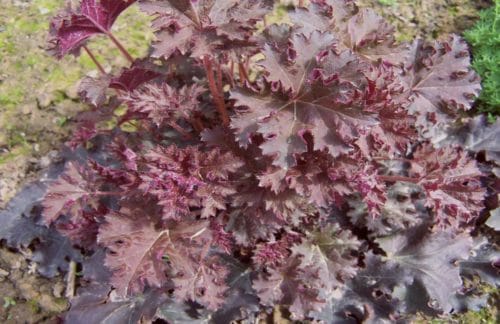

The color of the leaves of the Melting Fire variety changes with the age of the plant: in a young shrub, they are light purple, and over time they become darker, to a brown shade
Hercules view
Among many other shrubs, it is not difficult to recognize the Hercules variety - the small-sized light green rounded leaves form a spherical bush. White veins are clearly visible on the leaves, which make it even lighter. The height of the shrub does not exceed 40 cm. During the flowering period, the plant throws out many bright peduncles, which have a pink, coral, red color.
Geichera Hercules feels most comfortable in partial shade, in an open area under the constant sun the leaves will begin to dry out and fade. Regular watering and good soil drainage is the key to active and healthy plant growth.
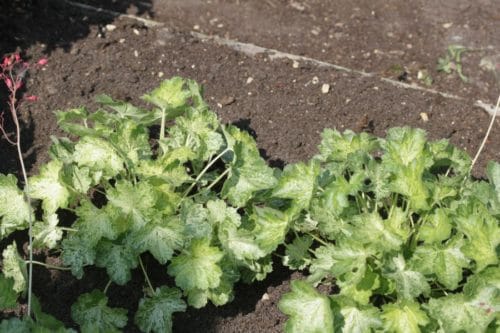

This plant variety differs from others in the modestness of the color and shape of the leaves. But from this it is no less appreciated by flower growers and landscape designers.
Geichera Marvelous Marble
The Marvelos Marble variety looks good on any flower garden. The blurred color of the leaves, combining dark brown spots and green veins with edging, attracts attention. It becomes even brighter at the end of spring, when it throws out snow-white flower stalks.
The peculiarity of this variety is frost resistance, at the end of autumn it may not even be covered, like other types of Heuchera.
In addition, Marvelos Marble is practically not susceptible to attack by pests, which makes it even easier to care for it. The small size of the shrub makes it possible to plant them along the paths or in decorative pots, for example, to decorate the veranda.
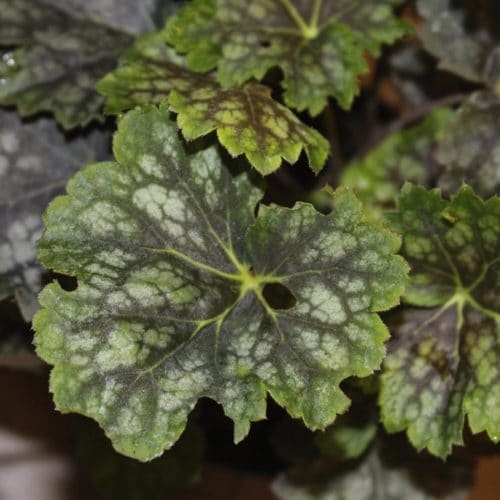

This variety differs from most others in that it combines several shades on the surface of the leaves - most often green with brown
Green Spice variety
The height of the Geykhera Green Spice shrub reaches 40 cm, while the long legs with peduncles can rise another 20 cm above the plant. It is one of the most common perennial species, its small rounded leaves are light green with dark veins. With the onset of autumn coolness, the foliage of Green Spice changes color and becomes yellow-brown. Such a change in shades looks attractive against the background of other Heuchera varieties, which do not change the color of the leaves over time.
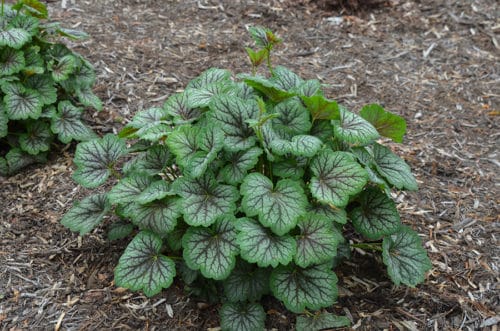

Geichera Green Spice is one of the varieties of an American plant variety that feels most comfortable in partial shade and moderately moist soil.


